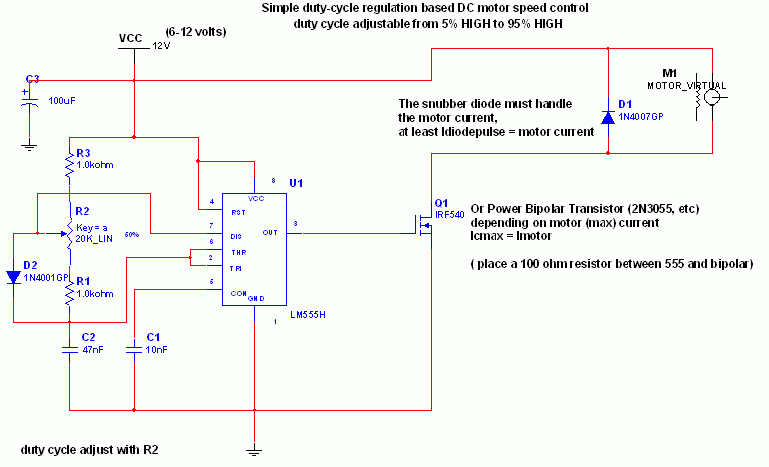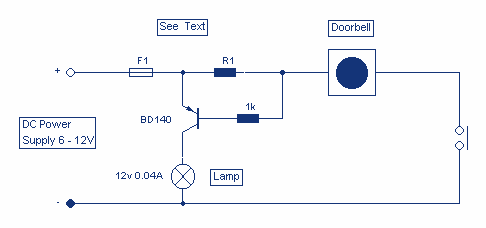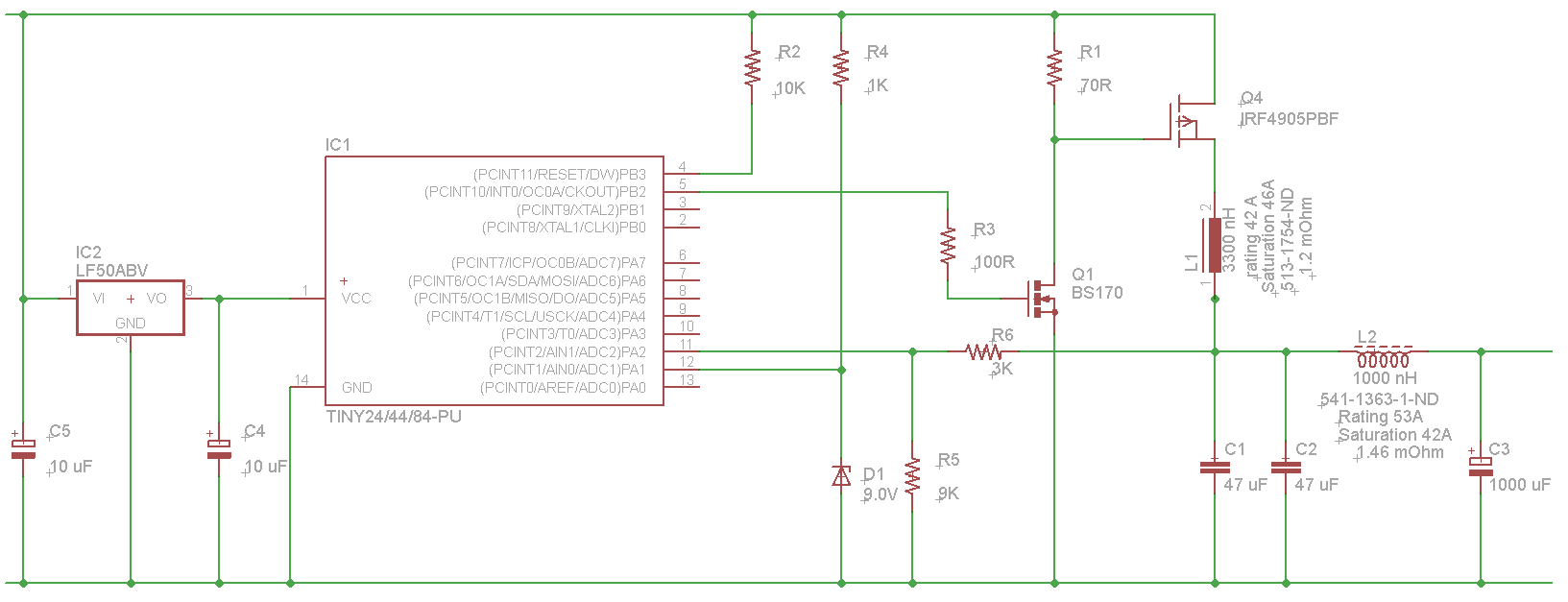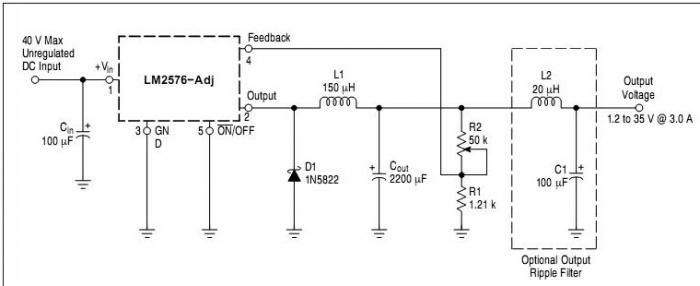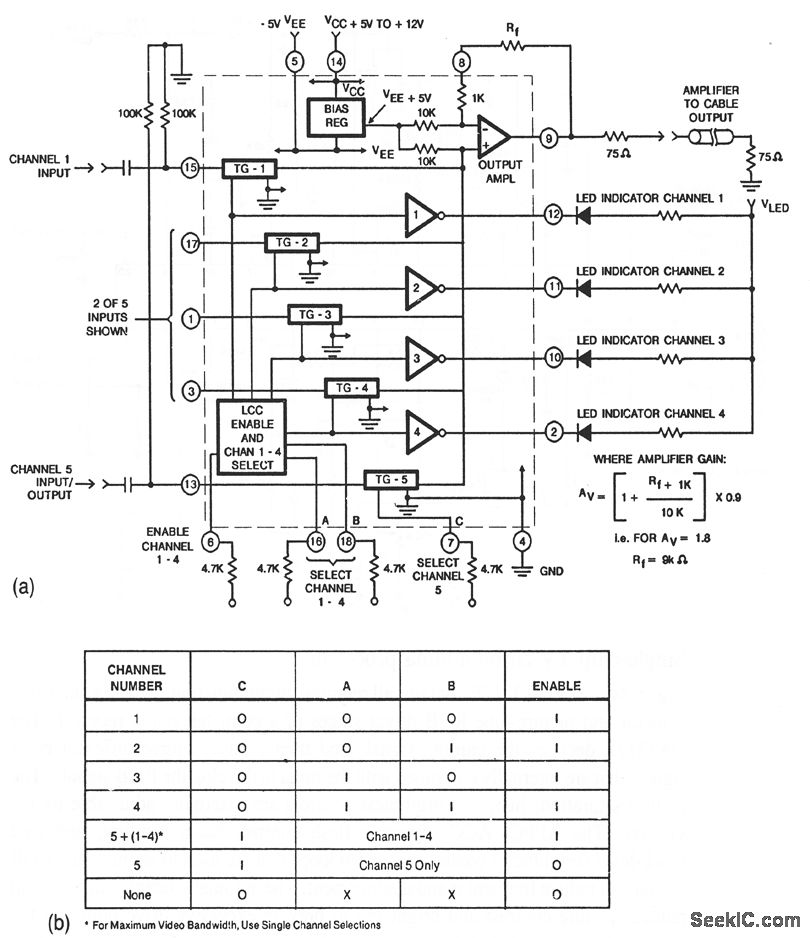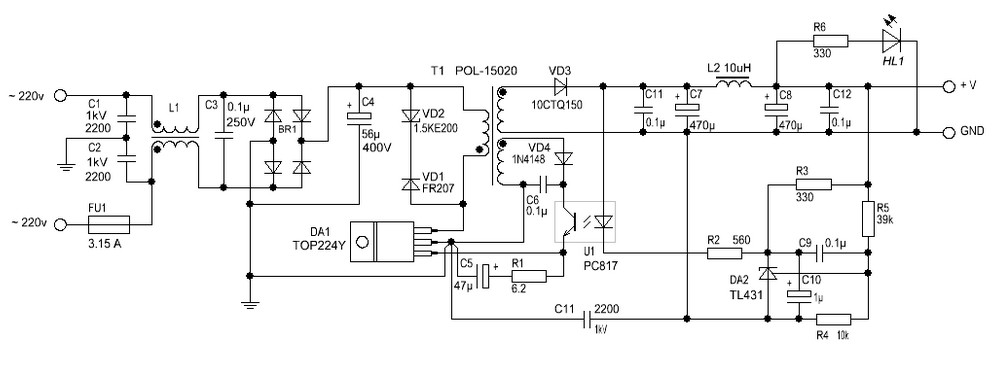
A Simple Keypad-Operated Switch - with enhanced security
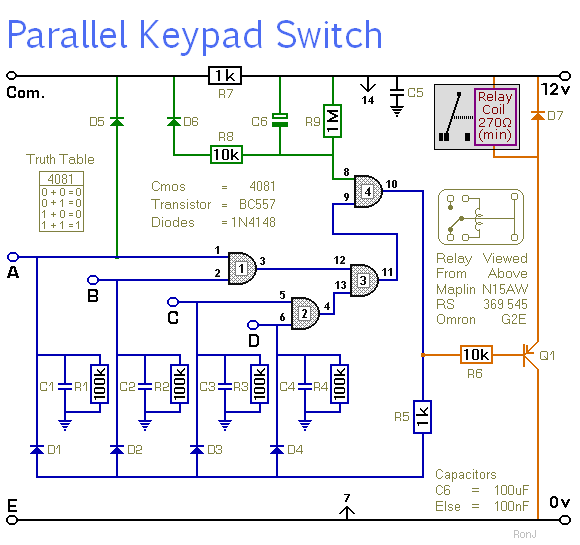
This is a universal four-digit keypad-operated switch with a unique feature. Instead of entering the security code one digit at a time, all four keypad buttons must be pressed simultaneously. This means the four numbers must be entered in parallel, making it difficult for an intruder to determine the code or even the number of digits in the code. An additional layer of security is provided by a secret time-lock. After several incorrect code attempts, the circuit will stop responding to the keypad, preventing further attempts to crack the code. To disable the time-lock feature, omit components D6, C6, R8, and R9, and connect pins 8 and 9 of the integrated circuit (IC) together. For a three-digit security code, leave out D4, C4, and R4, and connect pins 5 and 6 of the IC together, as three digits are easier to enter than four. It is important not to use the onboard relay for switching mains voltage due to insufficient isolation between relay contacts and low-voltage components. If mains voltage switching is required, a suitably rated relay should be mounted safely away from the board. The user can select four keys for the code and connect them to terminals "A," "B," "C," and "D." Since the keys must be pressed simultaneously, the connection order is irrelevant. The keypad's common terminal should be connected to "Com," and the remaining keys should be grounded to "E." Upon powering up, the relay will be energized, and pressing keys "A," "B," "C," and "D" simultaneously will de-energize the relay. To re-energize it, any key not part of the code, connected to "E," should be pressed. To reverse the circuit's action, the PNP transistor can be replaced with an NPN transistor. Using a BC547 instead of a BC557 will result in the circuit powering up with the relay de-energized, energizing it upon code entry. If multiple incorrect code attempts are made, the circuit will lock out the user, with the lockout duration determined by the value of R8. If locked out, the user must wait approximately one minute before entering the correct code, with the wait time primarily influenced by the value of R9. If the user does not wait long enough and continues to enter incorrect codes, the circuit will remain locked out. The total number of possible codes or key patterns depends on the number of keys on the keypad. A 12-key pad offers 495 different combinations of four keys, while a 16-key pad allows for 1820 combinations. Additionally, the code can be split between two separate keypads, requiring two people to operate the switch if the keypads are positioned far apart. Each person can have their unique three-digit security code following the guidelines provided on the Support Page under General Information. The keypad must have a common terminal and individual connections for each key; a 12-key pad should have 13 terminals, as matrix types with 7 or 8 terminals are not suitable. The support material for this circuit includes details for creating an appropriate keypad, a comprehensive circuit description, a parts list, and a step-by-step construction guide for the circuit board.
The universal four-digit keypad-operated switch circuit is designed to enhance security through simultaneous code entry and a time-lock feature. The circuit utilizes a microcontroller or IC to process input from the keypad. The simultaneous pressing of four keys is detected by the microcontroller, which then verifies whether the input matches the stored security code. If the code is correct, the microcontroller will deactivate a relay, allowing connected devices to operate.
The time-lock feature is implemented using a combination of resistors and diodes to create a delay after incorrect attempts. The values of resistors R8 and R9 can be adjusted to modify the lockout duration, providing flexibility in how the security system responds to unauthorized access attempts.
In terms of hardware, the circuit requires careful layout considerations to ensure that low-voltage components are adequately isolated from high-voltage relay contacts. The choice of a relay should be based on the specific load requirements, and it should be mounted in a location that minimizes risk.
The keypad should be chosen based on the number of keys desired, with a recommendation for a matrix-type keypad that provides individual connections for each key. The circuit's design allows for scalability, enabling the use of larger keypads to increase the number of possible combinations and enhance security.
Overall, this keypad-operated switch circuit is a robust solution for applications requiring secure access control, with features that can be tailored to meet specific user needs while maintaining a high level of security.This is a universal four-digit keypad-operated switch - with a difference. Instead of entering the security code one number at a time - the four keypad buttons must be pressed simultaneously. In other words - the four numbers must be entered in parallel. The intruder won`t know the code. He won`t even know how many digits there are in the code. An d he almost certainly won`t know that the entire code must be entered simultaneously. Added to this - is the extra layer of security provided by the secret time-lock. After a few incorrect codes are entered - the circuit will stop responding to the keypad. And any further attempts to crack the code - will be unsuccessful. If you don`t want the time-lock feature - leave out D6, C6, R8 & R9. And connect pins 8 & 9 of the IC together. If you want to use a three-digit security code - leave out D4, C4 & R4. And connect pins 5 & 6 of the IC together. Three digits are easier to enter than four. Do not use the "on-board" relay to switch mains voltage. The board`s layout does not offer sufficient isolation between the relay contacts and the low-voltage components. If you want to switch mains voltage - mount a suitably rated relay - somewhere safe - Away From The Board.
Choose the four keys you want to use for your code - and connect them to "A B C & D". Since the keys have to be pressed simultaneously - the order in which you make the connections is irrelevant. Wire the keypad`s common terminal to "Com". And connect all the remaining keys to ground. That is - to "E". The circuit will power-up with the relay energized. When you press keys "A B C & D" simultaneously - the relay will de-energize. To energize it again - press any key not included in your code. That is - any key connected to "E". If you want to reverse the action of the circuit - replace the PNP transistor - with an NPN transistor.
If you use a BC547 instead of a BC557 - the circuit will power-up with the relay de-energized. And it will energize when you enter your code. If you make more than a couple of attempts to enter an incorrect code - the circuit will lock you out. How quickly it does so - depends on the value of R8. If you are locked out - you must wait for a minute or so - before you enter the correct code. How long you have to wait - depends mainly on the value of R9. If you don`t wait long enough - and you keep trying to enter incorrect codes - the circuit will keep you locked out.
The total number of different codes - or key patterns - available depends on the number of keys in your pad. With a 12-key pad - there`s a choice of 495 different groups of four keys. If you want a more secure code - use a bigger keypad. A 16-key pad lets you choose from 1820 different groups of four. You can also split the code between two separate keypads. If you mount the keypads far enough apart - two people will have to be present in order to operate the switch.
And by using the technique described on the Support Page - under the heading - General Information - each person can have his own unique three-digit security code. The keypad itself must be the kind with a common terminal - and a separate connection for each key. On a 12-key pad - look for 13 terminals. The matrix type with 7 or 8 terminals will NOT do. The Support Material for this circuit includes details of how to make a suitable keypad. It also includes a detailed circuit description - a parts list - a step-by-step guide to the construction of the circuit board - and more.
🔗 External reference
The universal four-digit keypad-operated switch circuit is designed to enhance security through simultaneous code entry and a time-lock feature. The circuit utilizes a microcontroller or IC to process input from the keypad. The simultaneous pressing of four keys is detected by the microcontroller, which then verifies whether the input matches the stored security code. If the code is correct, the microcontroller will deactivate a relay, allowing connected devices to operate.
The time-lock feature is implemented using a combination of resistors and diodes to create a delay after incorrect attempts. The values of resistors R8 and R9 can be adjusted to modify the lockout duration, providing flexibility in how the security system responds to unauthorized access attempts.
In terms of hardware, the circuit requires careful layout considerations to ensure that low-voltage components are adequately isolated from high-voltage relay contacts. The choice of a relay should be based on the specific load requirements, and it should be mounted in a location that minimizes risk.
The keypad should be chosen based on the number of keys desired, with a recommendation for a matrix-type keypad that provides individual connections for each key. The circuit's design allows for scalability, enabling the use of larger keypads to increase the number of possible combinations and enhance security.
Overall, this keypad-operated switch circuit is a robust solution for applications requiring secure access control, with features that can be tailored to meet specific user needs while maintaining a high level of security.This is a universal four-digit keypad-operated switch - with a difference. Instead of entering the security code one number at a time - the four keypad buttons must be pressed simultaneously. In other words - the four numbers must be entered in parallel. The intruder won`t know the code. He won`t even know how many digits there are in the code. An d he almost certainly won`t know that the entire code must be entered simultaneously. Added to this - is the extra layer of security provided by the secret time-lock. After a few incorrect codes are entered - the circuit will stop responding to the keypad. And any further attempts to crack the code - will be unsuccessful. If you don`t want the time-lock feature - leave out D6, C6, R8 & R9. And connect pins 8 & 9 of the IC together. If you want to use a three-digit security code - leave out D4, C4 & R4. And connect pins 5 & 6 of the IC together. Three digits are easier to enter than four. Do not use the "on-board" relay to switch mains voltage. The board`s layout does not offer sufficient isolation between the relay contacts and the low-voltage components. If you want to switch mains voltage - mount a suitably rated relay - somewhere safe - Away From The Board.
Choose the four keys you want to use for your code - and connect them to "A B C & D". Since the keys have to be pressed simultaneously - the order in which you make the connections is irrelevant. Wire the keypad`s common terminal to "Com". And connect all the remaining keys to ground. That is - to "E". The circuit will power-up with the relay energized. When you press keys "A B C & D" simultaneously - the relay will de-energize. To energize it again - press any key not included in your code. That is - any key connected to "E". If you want to reverse the action of the circuit - replace the PNP transistor - with an NPN transistor.
If you use a BC547 instead of a BC557 - the circuit will power-up with the relay de-energized. And it will energize when you enter your code. If you make more than a couple of attempts to enter an incorrect code - the circuit will lock you out. How quickly it does so - depends on the value of R8. If you are locked out - you must wait for a minute or so - before you enter the correct code. How long you have to wait - depends mainly on the value of R9. If you don`t wait long enough - and you keep trying to enter incorrect codes - the circuit will keep you locked out.
The total number of different codes - or key patterns - available depends on the number of keys in your pad. With a 12-key pad - there`s a choice of 495 different groups of four keys. If you want a more secure code - use a bigger keypad. A 16-key pad lets you choose from 1820 different groups of four. You can also split the code between two separate keypads. If you mount the keypads far enough apart - two people will have to be present in order to operate the switch.
And by using the technique described on the Support Page - under the heading - General Information - each person can have his own unique three-digit security code. The keypad itself must be the kind with a common terminal - and a separate connection for each key. On a 12-key pad - look for 13 terminals. The matrix type with 7 or 8 terminals will NOT do. The Support Material for this circuit includes details of how to make a suitable keypad. It also includes a detailed circuit description - a parts list - a step-by-step guide to the construction of the circuit board - and more.
🔗 External reference
